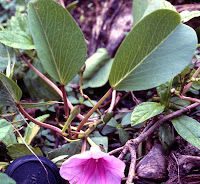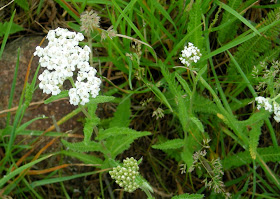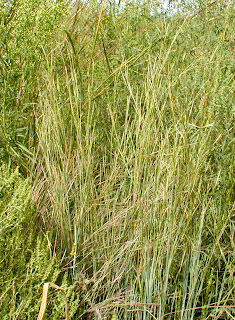 |
| prickly pear cactus |
 |
| morning glory, Padre Island, Texas |
 |
| morning glory Happy Grove, Jamaic |
Here’s a purple-flowered morning glory from the beach in from Jamaica and in Texas. Same or different?
 |
| yarrow, Boulder Colorado |
Yarrow from Narvik, Norway and Boulder, Colorado. Same or different?
Linnaeus set up a hierarchical system: groups are made of subgroups made of more subgroups. It was logical and mostly it worked. His hierarchy was Kingdom, Phylum for animals/ Division for plants, Class, Order, Family, Genus and Species.
 |
| carrots, Daucus carota |
 |
| apple, Malus domesticus |
 |
| dandelion, Taraxacum officinale |
In the 1750s, educated Europeans communicated in Latin. When the Roman Empire dominated Europe, everyone spoke Latin and people who read and wrote, read and wrote Latin. During the Middle Ages, education was mainly through the Catholic Church and they used Latin, partly for historical reasons and partly because a single language in the church facilitated communication. By Linneaus’ time, more and more was being written in local languages, but Latin remained a language that most educated people learned. Consequently, Linneaus wasn’t being difficult but, rather, cosmopolitan in setting up the scientific names as Latin names. His native language was Swedish.
The first name, the genus, is the larger category. It is always capitalized. It can stand alone. In contrast, the second name separates a particular kind (species) of plant and is never used by itself. No two different plants have identical two-part (binomial) names, but the various members of a genus share the generic name, as in Helianthus annuus, Helianthus grosseserratus, and Helianthus petiolaris, the common sunflower, the sawtooth sunflower and the prairie sunflower, respectively.
Scientific names are written in italics in an English text because they are treated as being in Latin, a foreign language to English. (See previous blog: Botany Rules 1)
The first name, the genus, is the larger category. It is always capitalized. It can stand alone. In contrast, the second name separates a particular kind (species) of plant and is never used by itself. No two different plants have identical two-part (binomial) names, but the various members of a genus share the generic name, as in Helianthus annuus, Helianthus grosseserratus, and Helianthus petiolaris, the common sunflower, the sawtooth sunflower and the prairie sunflower, respectively.
 |
| sawtooth sunflower, Helianthus grosseserratus |
 |
| common sunflower, Helianthus annuus |
 |
| prairie sunflower, Helianthus petiolaris |
Note how the adjective form of genus, generic, means a category in English and the adjective of species, specific, means a particular one.
Both words, genus and species, form their plurals in English the way they did in Latin: 1 genus, 2 genera; 1 species, 2 species. Economists use specie as the singular, biologists do not.
Scientific names don’t have to be multisyllable horrors. They just tend to be. There are some short ones: Rhus is the genus of sumac, Rhus glabra is smooth sumac, Acer is maple, Acer nigrum black maple, Zea mays corn. Perhaps the long names are because we have over 300,000 plant species and therefore over 300,000 scientific names, with no duplication.
Frequently Linnaeus took the name you’d find in a Latin dictionary for the plant and made that the genus name. For example Hordeum for barley, Rosmarinus for rosemary, and Avena for oats. For plants not known in Rome, often the namers of the plant Latinized the common name, for example Nelumbo (from Ceylonese), Cakile (an old Arabic name), Gelsemium (Italian name of that plant) and so on. Some others are intended to be descriptive: Dichondra from the Greek, two (di) and fruit (chondra), Symphoricarpos (composed from Greek symphorein to bear together and carpos fruit, for the clustered berries), Campanula (Latin “little bell”), Cardiospermum (composed from Greek cardios, heart and sperma seed).
One genus may contain many different species. The species name for a plant indicates genus and species with the second word, called the "specific epithet"--the awkward jargon reinforcing the idea that it never stands alone--treated as modifying the genus. In English we add an adjective to indicate which sunflower: "the common sunflower not the sawtooth sunflower." The two words of the plant's scientitic name function the same way: which Helianthus? Helianthus annuus (literally, the annual sunflower, which it is). Helianthus grosseserratus is called the sawtooth sunflower in the USDA plants list: grosseserratus means large serrations. Serrations on a leaf can be called teeth, and so big tooth or sawtooth sunflower. I don't have picture that shows the leaves well, but the leaves have even bigger "teeth" than dandelion leaves. For Helianthus petiolaris, the Latin name draws attention to the long petiole (stem on the leaf). It is a common plant, so it has a better English name, one that refers to its distribution, the prairie sunflower.
 |
| Piper nigrum, black pepper |
Some often-used words used for specific epithets are obvious adjectives: alba white, azurea blue, orientale eastern, minima, small, etc. Another set refer to the origin of the plant: japonica, floridana, californica. Adding -ensis is another way of doing that: jamaicensis, nebraskensis. Finally, the plant can be named after a person, usually to honor them: parryi from Parry, gerardii from Gerard. These can be very awkward because the proper spelling in Latin for word ending in a consonant used as a possessive (genitive) is with two i’s, so Andropogon gerardii, Gerard’s bluestem, Andropogon hallii Hall’s bluestem. (These two have easier common names, big bluestem and sand bluestem).
Modern scientific usage never capitalizes the specific epithet, no matter what. In the past a variety of species were capitalized but not today, which is nice, because it isn’t easy to recognize which ones were capitalized and which were not.
Modern scientific usage never capitalizes the specific epithet, no matter what. In the past a variety of species were capitalized but not today, which is nice, because it isn’t easy to recognize which ones were capitalized and which were not.
 |
| Rocky Mountain bee plant, Cleome serrulata |
 |
| Chamaecrista fasiculata partridge pea |
In the published literature you see abuses of this, where, especially in graphs, the scientific names were too long so they abbreviated the genus and then nobody checked whether the genus was written out somewhere else. That's fine if you know that S. gardeneri in a paper on Chamaecrista is likely to be Senna, but that's an assumption the authors and editors really shouldn't make. It certainly doesn't assist the busy reader trying to read the article to have to search to find out what the abbreviation refers to.
Another common shortcut is writing sp., the abbreviation for species (singular) after the genus name, or spp. (for more than one species). If I write Populus sp., I am saying, “an aspen but I don’t know which one.” In contrast, Populus spp. would be “several species of aspen.” The abbreviations sp. and spp. are considered to be English and are not italicized.
 |
| Schizachryium scoparium, little bluestem |
References used
Fernald, M.L. 1950. Gray’s Manual of Botany, 8th ed. D. Van Nostrand, Co., New York.
Lewis, C. T. 1919. A Latin dictionary for schools. American Book Company, New York.
USDA plants website http://plants.usda.gov/java/
Questions and comments welcome!
I rewrote this post slightly on August 13, 2014 because reader Barry Anderson pointed out that "species name" properly refers to the binomial (for example, Rhus glabra) and that if I want to talk about the glabra part, I should call it the specific epithet. He is correct, so I have made my choice of words above more precise.
New Offer: I combined my blogs about writing and saying plant names into an ebook, entitled Botany Rules.
It's free.
To receive your copy click here: Botany Rules ebook
P.S. It will put you on my mailing list but I won't abuse your mailbox and you can unsubscribe at any time.
Kathy Keeler, A Wandering Botanist
More at awanderingbotanist.com
Join me on Facebook

Great post. Looking forward to reading more. Thanks for taking the time to write this.
ReplyDeletemicrosoft 365 backup malaysia
cloud backup service
disaster recovery services malaysia